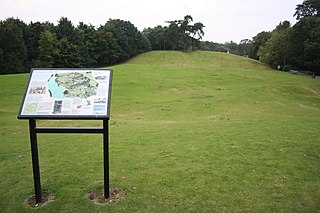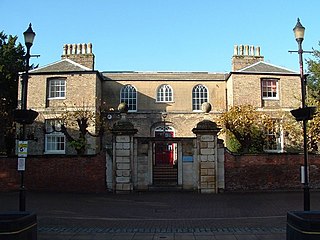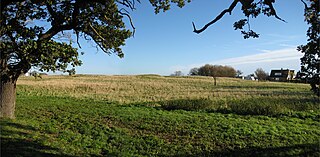 W
WThis list of castles in England is not a list of every building and site that has "castle" as part of its name, nor does it list only buildings that conform to a strict definition of a castle as a medieval fortified residence. It is not a list of every castle ever built in England, many of which have vanished without trace, but is primarily a list of buildings and remains that have survived. In almost every case the buildings that survive are either ruined, or have been altered over the centuries. For several reasons, whether a given site is that of a medieval castle has not been taken to be a sufficient criterion for determining whether or not that site should be included in the list.
 W
WBurwell Castle was an unfinished medieval enclosure castle in Burwell, Cambridgeshire, England.
 W
WCambridge Castle, locally also known as Castle Mound, is located in Cambridge, Cambridgeshire, England. Originally built after the Norman conquest to control the strategically important route to the north of England, it played a role in the conflicts of the Anarchy, the First and Second Barons' Wars. Hugely expanded by Edward I, the castle then fell rapidly into disuse in the late medieval era, its stonework recycled for building purposes in the surrounding colleges. Cambridge Castle was refortified during the English Civil War but once again fell into disuse, used primarily as the county gaol. The castle gaol was finally demolished in 1842, with a new prison built in the castle bailey. This prison was demolished in 1932, replaced with the modern Shire Hall, and only the castle motte and limited earthworks still stand. The site is open to the public daily and offers views over the historic buildings of the city.
 W
WCheveley Castle was a medieval fortified manor house near Cheveley, Cambridgeshire, England.
 W
WEaton Socon Castle was a Norman fortification. It was constructed next to the River Great Ouse in what is now Eaton Socon, Cambridgeshire, England.
 W
WEtton is a village and civil parish in the unitary authority area of the city of Peterborough, Cambridgeshire, in England. For electoral purposes it forms part of Northborough ward in North West Cambridgeshire constituency. The parish had a population of 158 persons and 58 households in 2001.
 W
WHuntingdon Castle was situated in the town of Huntingdon in Cambridgeshire.
 W
WKimbolton Castle is a country house in Kimbolton, Huntingdonshire, Cambridgeshire. It was the final home of King Henry VIII's first wife, Catherine of Aragon. Originally a medieval castle but converted into a stately palace, it was the family seat of the Dukes of Manchester from 1615 until 1950. It now houses Kimbolton School.
 W
WKirtling Tower was a medieval castle and Tudor country house in Kirtling, Cambridgeshire, England, of which the gatehouse still remains.
 W
WMaxey Castle was a medieval fortified manor house castle in Maxey, Cambridgeshire, England.
 W
WPeterborough Castle, also known as Mount Thorold and Touthill, was a medieval motte and bailey castle in Peterborough, Cambridgeshire, England.
 W
WRampton Castle, known locally as Giant's Hill, is the earthwork remains of a motte and bailey castle in Rampton, Cambridgeshire. It is believed that the castle was constructed during The Anarchy by the forces of King Stephen to contain the revolt of Geoffrey de Mandeville. The castle was not completed; construction was probably halted by de Mandeville's death at nearby Burwell Castle in 1144. Sited near to the churchyard of All Saints' Church, the castle is thought to have been built over the eastern end of the medieval village.
 W
WWisbech Castle was a stone to motte-and-bailey castle built to fortify Wisbech on the orders of William I in 1072, it probably replaced an earlier timber and turf complex. The layout was probably oval in shape and size, on the line still marked by the Circus. The original design and layout is unknown. It was rebuilt in stone in 1087. The castle was reputedly destroyed in a flood in 1236. In the 15th century, repairs were becoming too much for the ageing structure, and a new building was started in 1478 under John Morton, Bishop of Ely. His successor, John Alcock, extended and completed the re-building and died in the Castle in 1500. Subsequent bishops also spent considerable sums on this new palace. The Bishop's Palace was built of brick with dressings of Ketton Stone, but its exact location is unknown.
 W
WWoodcroft Castle is a moated medieval castle in the parish of Etton, Cambridgeshire, England.
 W
WWoodwalton Castle was a small motte and bailey castle at Church End, the northern end of the parish of Woodwalton, Huntingdonshire. Located on a natural hillock, the earthworks of the castle still remain, with an outer moat enclosing a circular bailey with a central motte. A large dyke, apparently ancient, runs from the outer moat in a north-easterly direction. The site is a scheduled monument.
 W
WZouches Manor was an Anglo-Saxon moated manor in Fulbourn Fen, a Site of Special Scientific Interest in the village of Fulbourn, Cambridgeshire, England. It is one of the historic Five Manors of Fulbourn and recorded to have existed 1066 AD to 1539 AD.